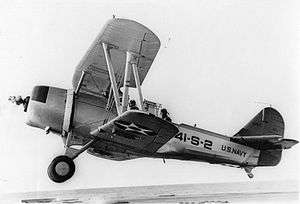Vought SBU Corsair
The Vought SBU-1 Corsair was a two-seat, all-metal biplane dive bomber built by Vought Aircraft Company of Dallas, Texas for the US Navy. Its design was based upon the F3U-1 two-seat fighter that was abandoned when the Navy decided not to obtain any more two-seat fighters.
| SBU | |
|---|---|
 | |
| A SBU-1 of Scouting Squadron 41 | |
| Role | Dive bomber |
| National origin | United States |
| Manufacturer | Vought |
| First flight | May 1933 |
| Primary user | United States Navy |
| Number built | 125 |
| Developed from | Vought XF3U |
| Developed into | Vought XSB3U |
Design and development
The aircraft was equipped with a closed cockpit, had fixed landing gear, and was powered by a Pratt & Whitney R-1535 radial air-cooled engine as had the F3U-1, but also included a controllable pitch propeller and a new NACA cowl with adjustable cowling gills on the trailing edge of the cowl. The adjustable cowling gills permitted better control of cooling airflow over the engine.
The SBU-1 completed flight tests in 1934 and went into production under a contract awarded in January 1935. The Corsair was the first aircraft of its type, a scout bomber, to fly faster than 200 mph. The last SBU Corsairs were retired from active service in 1941, being reassigned as trainers.[1]
The name "Corsair" was used several times by Vought's planes; the O2U/O3U, SBU, F4U, and the A-7 Corsair II.
Variants
- XF3U-1
- Two-seat fighter prototype with a 700 hp R-1535-64 engine.[2]
- XSBU-1
- The XF3U-1 converted to scout bomber prototype with a 700 hp R-1535-96 engine, later used as an engine test bed.[3]
- SBU-1
- Original production order; 84 aircraft with 750 hp R-1535-82 engine.[3]
- SBU-2
- Follow-on order; 40 aircraft with R-1535-98 engines.[3]
- Model V.142A
- Export version for Argentina.[3]
Specifications (SBU-1)
Data from United States Navy Aircraft since 1911
General characteristics
- Crew: two: pilot, navigator/gunner
- Length: 27 ft 10 in (8.49 m)
- Wingspan: 36 ft 3 in (10.14 m)
- Height: 11 ft 11 in (3.63 m)
- Wing area: 327 sq ft (30.4 m2)
- Empty weight: 3,645 lb (1,659 kg)
- Max takeoff weight: 5,520 lb (2,509 kg)
- Powerplant: 1 × Pratt & Whitney R-1535-80 Twin Wasp Junior 14-cylinder two-row air-cooled radial engine, 700 hp (522 kW)
Performance
- Maximum speed: 178 kn (205 mph, 330 km/h) at 8,900 ft (2,700 m)
- Cruise speed: 106 kn (122 mph, 196 km/h)
- Range: 477 nmi (548 mi, 882 km)
- Service ceiling: 23,700 ft (10,800 m)
- Rate of climb: 1,180 ft/min (6.0 m/s)
Armament
- Guns: 1x Fixed forward firing .30 in (7.62 mm) Browning machine gun and 1x machine gun flexibly mounted .30 in machine gun in rear cockpit
- Bombs: 1x 500 lb (227 kg) bomb
References
- Notes
- Johnson 2008, p. 306.
- Andrade 1979, p. 192
- Andrade 1979, p. 222
- Bibliography
- Andrade, John (1979). U.S.Military Aircraft Designations and Serials since 1909. Midland Counties Publications. ISBN 0 904597 22 9.
- Johnson, E.R. (2008). American Attack Aircraft Since 1926. Jefferson, NC: McFarland & Company. ISBN 978-0-7864-3464-0.
- Swanborough, Gordon and Bowers, Peter M. United States Navy Aircraft since 1911. London:Putnam, 1976. ISBN 0-370-10054-9.
External links
![]()